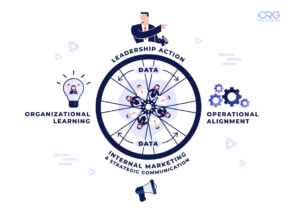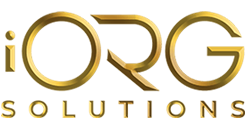Change Management Model
The change management discipline has come a long way in the last 40 years. As such there are various models that can help your organization manage change. All of these models provide a framework, making into science a field that’s rather like art. The art part is due to the unpredictable nature of human dynamics when change is introduced. We’re dealing with people after all, not robots programmed with 0s and 1s. A change management model wouldn’t be complete without elements of art infused into it. Art and science underscore what a change management program should look like to successfully support a business transformation.
 Most models have a few common elements, which you can also see with our approach in the diagram above. Leadership behaviors are critical – without the brilliance of a leader (ahem) why would any initiatives start in the first place. Next are the particulars of different functions in a company surrounding the change. The particulars include not just processes and procedures within each function, but also the employee profiles that shape the culture of each. We all know Finance folks are very different from HR folks, but are there commonalities they both share?
Most models have a few common elements, which you can also see with our approach in the diagram above. Leadership behaviors are critical – without the brilliance of a leader (ahem) why would any initiatives start in the first place. Next are the particulars of different functions in a company surrounding the change. The particulars include not just processes and procedures within each function, but also the employee profiles that shape the culture of each. We all know Finance folks are very different from HR folks, but are there commonalities they both share?
The third and fourth elements most people are familiar with in a change effort are communication and training. Common sense has it that the change should be communicated to people affected. But guess what? It doesn’t or if it does get communicated, it’s done at the 11th hour without a preemptive plan to address impacts to employee engagement. If training is needed to up-skill affected employees, eventually all will get trained but initially, pockets of employees will be missed.
We’ve developed a model that addresses these components and the gaps mentioned, but we also like to be different, only for the sake of effectiveness. We like to codify the art in our approach as much as possible. We’ve found that by combining art and science, we’re able to do change effectively to help companies succeed. Building on the core components of the model, it goes like this:
- Leadership behavior is not just about setting the vision. It’s understanding what bold actions leaders should take and the right traits to embody to ignite employee commitment. Sometimes this means asking the difficult questions of oneself like: Am I doing the right thing in this situation?
- When it comes to internal operations, are you identifying all the impacts of the change effort, meaning are you missing the obvious pitfalls related to process AND people?
- Yes, communication is straight forward, but can communication be more strategic? Moreover, what lessons in traditional marketing, which is external facing, can we apply internally in an organization?
- Instead of calling the 4th component training, we like to think of it as organizational learning. Information needs to be codified but how can you keep ideas continually fresh and impactful in the absence of the individual? How can organizational learning be implemented with speed?
Note in the diagram on the spokes is the word Data. With art and science, sometimes it’s very difficult to know which change management tactics and strategies will hit the mark with employees. As such, we need to collect and analyze the data we receive from the interventions. The emphasis on data and its interpretations will help identify the best solution for your organizational complexities.
Let us know your thoughts to the questions above in the comments section. Stay tuned as we unpack both the art and science of each element in our model, and share with you real-world tips you can apply immediately for your company.



Thanks for sharing your very good web-site.
Just desired to say I’m just ecstatic that i came upon your web page.